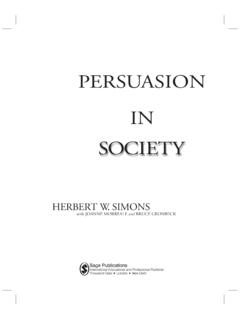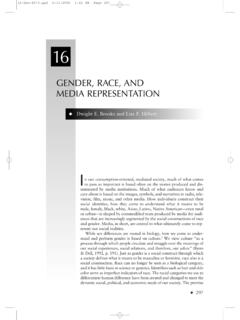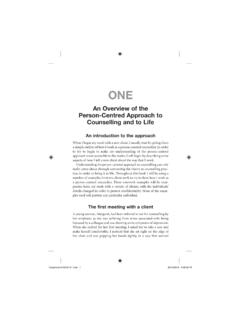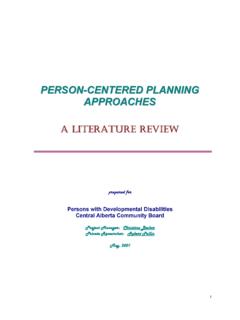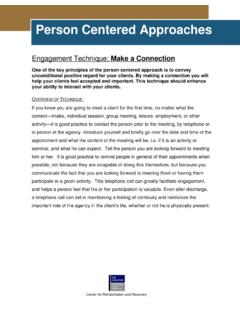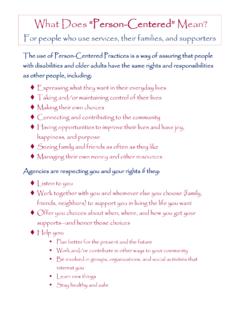Transcription of An Overview of the Person-Centred Approach to Counselling ...
1 1An Overview of the Person-CentredApproach to Counselling and to LifeAn introduction to theapproachUnderstanding the Person-Centred Approach to counsellingcan only really come about through connecting the theoryto Counselling practice, in order to bring it to life. Throughoutthis book I will be using a number of examples from myclient work to try to show how I work as person-centredcounsellor. These casework examples will be compositesfrom my work with a variety of clients, with the indivi-duals details changed in order to protect confidential-ity. None of the examples used will portray any I begin my work with a new client, I usually startby giving them a simple outline of how I work as a Person-Centred counsellor.
2 In order to try to begin to make myunderstanding of the Person-Centred Approach more accessi-ble to the reader, I will begin by describing some aspects ofhow I tell a new client about the way that I first meeting witha client A young woman, Margaret, had been referred to me forcounselling by her employer, as she was suffering 11/23/2005 11:52 AM Page 1stress through being harassed by a colleague and was showingsome symptoms of depression. When she arrived for herfirst meeting, I asked her to take a seat and make herselfcomfortable. I noticed that she sat right on the edge of herchair and was gripping her hands tightly, in a way thatseemed rather tense and ill at ease. I introduced myself andtold her that I was feeling a little nervous, which I usuallydo when meeting new people.
3 I then said in a very accept-ing way, that she also seemed a little tense and that I sus-pected she might be feeling a bit nervous or anxious too, atwhich she nodded quietly in agreement. I asked if she knewanything about Counselling , to which she cautiously replied No, not a thing . So I told her that I usually begin by talk-ing a little about the way that I work as a person-centredcounsellor, saying something about me and my backgroundand clarifying what we could expect from each other if weagreed to work together. I explained that I believed it wasimportant to do this, so that I could make it feel safe enoughfor her to talk to me about anything she wanted to. Sheagreed that this might be helpful and so I began:Well, Margaret, there are several different approaches tocounselling in this country and I have been trained towork as Person-Centred counsellor.
4 There are some impor-tant differences between this Approach and the other majorapproaches to Counselling . First of all, I have a very strong belief in the positivenature of all human beings. We will always strive to dothe best for ourselves, no matter what conditions we findourselves in or what problems we face. Secondly, I believe in the uniqueness and worth of everyindividual human being and that we all deserve respectfor our capacity to choose our own directions in life andto select and choose our own values to live Counselling in a 11/23/2005 11:52 AM Page 2 Thirdly, I believe that you are the only expert in your owninternal world and the only person who really knows howyou feel. You are the only person who can decide whoand how you should be, the only person who can decidewhat the meaning of your life is and what you should dowith it.
5 Fourthly, I believe that the most important thing in coun-selling is the therapeutic relationship that will developbetween us, in which I hope that you will really feelheard and understood, in a non-judgemental way and thatyou will experience me as a real and genuine person inthis relationship. I will often be very open with my feel-ings as I experience them here, rather than playing therole of counsellor or expert whom you have come to askfor solutions to your problems. I am not an expert: I do not have any answers to yourproblems and difficulties. I believe that the answers, ifthere are any, lie within you. I will not probe or pry intoanything you tell me, I will only work with what youchoose to talk about.
6 The only questions I will ask will beto check that I have heard and understood your feelingsor to clarify the meaning of what you are telling me. I amquite used to a lot of silence, tears and other strong feel-ings being will be very accepting of what you tell me and, at thesame time, I will notice when the words you say seem tobe at odds with how I am experiencing you. I might evennotice these things out loud, as I did at the start of thissession, when I saw that you seemed to be trying to lookvery calm and in control and yet there were lots of littlesignals that you were quite tense. I will do my best not tointerpret anything you do or say with my meanings, but Iwill try to clarify what these things mean for you and howyou are really Overview of the Person-Centred Approach to Counselling and to 11/23/2005 11:52 AM Page 3I will try to be sensitive in what I say to you and at thesame time I would want you to experience me as beingreally authentic with you and not putting on any will be very direct and honest in sharing how I experi-ence you and the things you talk about and you may findthis way of working quite challenging at times.
7 What I will try to do here, is create a trusting relationshipbetween us that will provide a safe space in which I hope youwill feel very accepted and understood so that you can be intouch with your feelings and talk, without fear, about any-thing which concerns you. I have a strong belief that we needto own and value all our feelings, even the most uncomfort-able ones and to be able to say how we feel and to insist onbeing heard and understood. I hope that you will experiencethat here with me so that you will feel able to deal more effec-tively with the feelings that are troubling , in a nutshell, is the Person-Centred Approach to words, or something very similar, are the way thatI usually start to develop a working relationship with anynew client, helping both them and me to settle down andrelax and begin to relate to each other.
8 It sounds fairly simpleand even rather like common sense, yet I know that to doit well requires considerable knowledge and the expertisethat comes from a lot of practice. These words also outlinewhat I believe are the basic principles of the person-centredapproach to brief history of thedevelopment of the Person-Centred approachOne of the criticisms of the Person-Centred Approach to coun-selling is that it is based on very little theory and at times hasPerson- centred Counselling in a 11/23/2005 11:52 AM Page 4even been described as theory thin . However, in this bookI aim to show that the Approach is underpinned by a richnessand depth of philosophy and theory, which it is important tounderstand in order to effectively practise in this way. Carl Rogers who was the originator of the person-centredapproach to Counselling , was born in 1902 in Chicago and diedin California in 1987, leaving behind the legacy of what hasbeen called the Third Force in American psychology, namely,humanistic psychology.
9 Rogers was the founder of what heoriginally called non-directive therapy (Rogers, 1942), whichlater he changed to calling client- centred therapy . Today itis more popularly known as the Person-Centred Approach . Inthe late 1940s, at the time that he began to develop his theo-ries, the other two forces prevalent in American psychologywere Psychoanalysis and Behaviourism, whose views on humannature were strongly challenged by Rogers. The development of the Person-Centred Approach stemmedfrom Rogers experience of being a client and his experi-ence of working as a counsellor, which gave rise to theviews he developed about the Behaviourist and Psycho-analytic approaches to Counselling . Rogers felt that in gen-eral terms, the Behaviourists seemed to take the view thathuman beings are organisms that only react to stimuli,developing habits learned from experience; that individu-als are helpless and are not responsible for their ownbehaviour.
10 The Behaviourists seemed to be saying thatindividuals have been taught to think and behave in waysthat are unhelpful or maladaptive and that it was their jobto teach them to be different. Rogers also felt that thePsychoanalysts, particularly Freud, appeared to take the viewthat human beings are never free from the primitive pas-sions originating in their childhood fixations and are solelythe product of powerful biological drives. The Psycho-analysts emphasised the dark side of human nature withits destructive impulses, over which human beings seemedto have no control. 5An Overview of the Person-Centred Approach to Counselling and to 11/23/2005 11:52 AM Page 5 Rogers suggested that in both of these approaches, humanbeings were seen to have no choice and no control overthemselves, that individuals are inherently bad or weak, andare likely to get broken and will need the help of the coun-sellor as an expert who could mend the broken the process of therapy the counsellor would assess anddiagnose what was wrong with the client and identify thegoals for change which the client needed to achieve.
